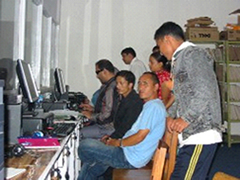- Country: Nepal
- Course Title: Technical Aid for Visually Disabled Persons, 2002 International Training and Dialogue
- Organizer: Tokyo International Center (JICA TOKYO)
What is DAISY?
JICA conducted a training course called "Technical Aid for Visually Disabled Persons" in 2002. The training course described how modern technology could be used to enhance the lives of people with disabilities.
The Digital Accessible Information SYstem (DAISY) is one of the best technologies available for producing Digital Talking Books (DTB), an updated multimedia form of talking books conventionally on media such as cassettes.
Early results of the training course
One of the course participants, Birendra Raj Pokharel, who is himself visually impaired, strongly believed that the DAISY specifications could significantly transform the experience of reading and learning for people with visual and print reading disabilities in Nepal. Pokharel returned to Nepal committed to adopting a DAISY at home. He began to explore the feasibility of establishing a "DAISY for All" (DFA) project in 2003. Three foreign volunteers decided to help Pokharel get the project running. These individuals assumed the roles of project manager, assistant project manager and international trainer. They visited Nepal in October 2004 to jump-start the establishment of a DAISY Focal Point in Nepal. Pokharel was designated a project coordinator at a major gathering of potential project stakeholders.
Establishment of a DAISY Focal Point in Nepal
Despite many political ups and downs during the direct regime of the former king, the government has given approval for the DAISY Focal Point. DFA has also agreed to provide grant support and technical cooperation for the project. Finally, a DAISY Focal Point in Nepal has been established. Following its successful establishment in Nepal, a Focal Point training course was conducted from 22 to 27 August 2005. The training was planned and conducted by Mr. Pokharel with the DFA assistant project manager from India. There were ten participants from organizations for the visually impaired from three countries, Nepal, Pakistan and Bhutan. The training also contributed to the establishment of a DAISY Focal Point in Pakistan in 2006.
Much-awaited spread of DTBs

DTB production training in Pokhara
To ensure adequate DTB production quality, the Nepal Association for the Blind, the Nepal Association for the Welfare of the Blind and the Special Technical Aid and Research Foundation -- which was established by Pokharel after attending the JICA's training course -- initiated the dissemination of the first DTBs in Nepal. As part of his role in the DFA project, Pokharel translated the adaptive multimedia information system (open-source playback software) into Nepali.
Presently, DTBs are being steadily produced in Nepal, greatly benefiting visually disabled students at the post-secondary education level. The DTB technology allows these individuals vital access to college-level publications in an easily accessible digital format. The end users of DTB include 150 blind and print reading disabled students who are provided with DTB playback machines by the DFA Project in Kathmandu.
As DAISY use spread in Nepal, the Kaski Blind Association collaborated with the FORCE Foundation of the Netherlands in establishing a national library on the P. N. Campus of Tribhuvan University in Pokhara. Pokharel has provided technical support and DTB production training. The campus library provides a venue for DTB creation and playback.
In addition, Pokharel persuaded the government to promote the extension of the DAISY throughout the Nepal. As a result, the Department of Education of the Ministry of Education and Sports, included funds for DAISY promotional activities in 2008 and 2009.

DTB player
Future strategic direction of the DFA Project
The latest initiative is to convert all text books into a digital format so that each student with a visual or print reading disability will have equal access to the benefits of the technology in a low cost, yet feature-rich, navigable format for all school levels. Although the government has already been distributing books written in Braille for visually impaired students, these are not sufficient for all students, particularly for those in remote locations. Therefore, we hope that the digitalization of all school-books will be promoted for use in a nation-wide, Internet accessible system. Pokharel and his supporters remain great advocates of the continued revision of governmental policies affecting individuals with visual and print reading disabilities.




scroll